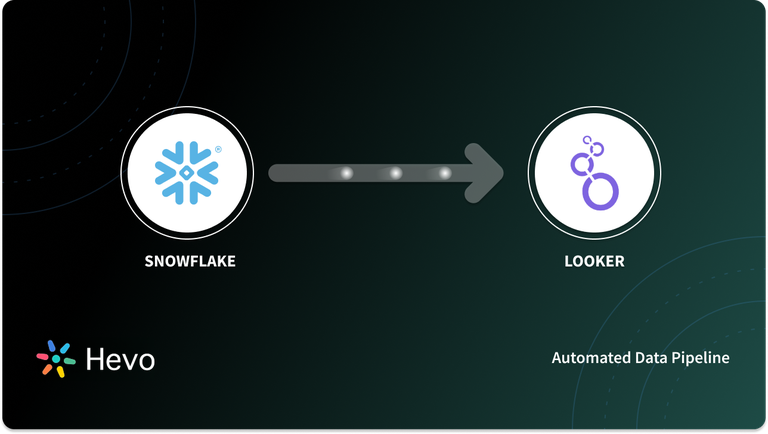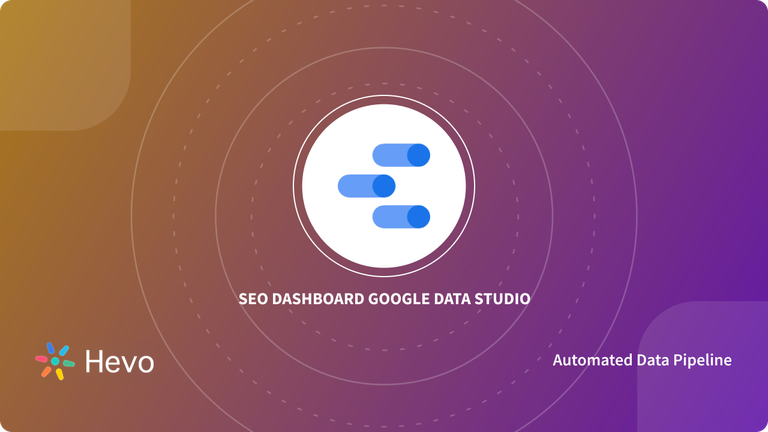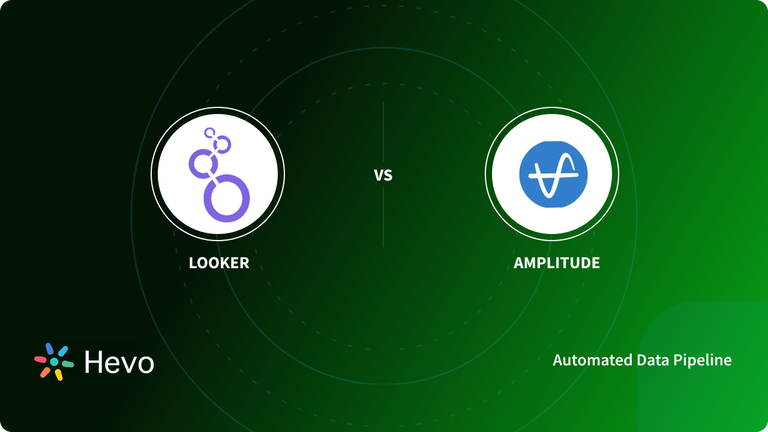Data management and storage have now become a standard yet essential industry practice. The data being collected and stored is constantly evolving, increasing in diversity and expanding in volume at an accelerated pace. It is becoming increasingly important that this data be utilized for the decision-making process by business organizations. Businesses of all sizes now rely on some degree of data and analytics for their operations and future decision strategies. Looker is one such platform that can help you perform this Data Analysis on the Web by connecting to your data sources in Real-Time.
In this article, you will be introduced to Looker and its key features. You will learn about Data Science Analytics, its benefits, the capabilities the Looker can provide in the process, the Workflow associated with Looker Data Sciences, and the functionality of Looker Blocks.
Building and maintaining data pipelines can be technically challenging and time-consuming. With Hevo, you can easily set up and manage your pipelines without any coding. With its intuitive interface, you can get your pipelines up and running in minutes.
Key-Benefits of using Hevo:
- Real-time data ingestion
- No-code platform
- Pre and Post-load transformations
- Automated Schema Mapping.
Join over 2000+ customers across 45 countries who’ve streamlined their data operations with Hevo. Rated as 4.7 on Capterra, Hevo is the No.1 choice for modern data teams.
Get Started with Hevo for FreeTable of Contents
What is Looker?
Looker is a Web-based Data Visualization and Business Intelligence platform used by various organizations to create Business Reports and real-time Dashboards. It is capable of transforming Graphical User Interface (GUI) based user input into SQL queries and then sending it directly to the database in live mode. It provides users with numerous visualizations and customization options tailored to their unique business needs. The platform supports multiple data sources and deployment methods so that you can use them for all your analytical needs without compromising the transparency, reliability, security, or privacy of your data, thereby making it the right choice for mission-critical needs.
Looker works perfectly with data connections with Cloud-based Data Warehouses like Google BigQuery, Amazon Redshift, or Snowflake, which can be scaled up or down as per requirements to manage the levels of user concurrency and query load and thus optimize business cost. Looker Data Sciences house a Data Modeling layer that is separate from the components that help visualize data. The functionalities offered by this layer can be leveraged by developers to transform data, perform numerous join operations across tables, etc. This feature is considered to be very important as it enables multiple developers to work simultaneously on a single model and then merge it using Github Sync.
More information about Looker can be found here.
Key Features of Looker
The key features of Looker are as follows:
- Create Custom Applications: Users can build custom applications to provide tailored visualization experiences to different organizations according to their needs.
- Support for Advanced Integrations: Platforms like Google BigQuery, Snowflake, AWS Redshift along with 50+ SQL dialects are supported using various Connectors and Integrations.
- Latest BI Tools: Robust support for creating Real-Time Dashboards is provided and support for the latest Business Intelligence tools is present to improve reporting.
- Support for Advanced Hosting: To ensure data reliability and safety, multiple Cloud-based platforms including Google Cloud Platform (GCP), and Amazon Web Services(AWS) are supported.
- Looker ML Functionality: This feature is also known as LookML and is used to describe the measures and dimensions of all the projects stored and being analyzed on Looker.
What is Data Science Analytics?
Data science refers to a process that uses computer programming to perform statistical modeling on large datasets stored in databases. It includes concepts such as Machine Learning Algorithms, Predictive modeling, Data mining, Data inference, etc. These processes are implemented to identify patterns from complex datasets. In Data Analytics, concepts of Statistics, Mathematics, and Statistical Analysis are used to gather actionable insights from data.
This analysis is used for finding meaningful correlations between datasets as well as to find the specifics of the extracted insights. In collaboration with Business Intelligence [BI] tools and concepts, Data Science is an effective decision-support system that provides objective parameters to enable business decisions as well as handle complex data from widely distributed sources that are generating it.
Implementation of Data Analytics requires good data governance and management, and it is supposed to be pre-processed and modeled properly to get meaningful results.
Benefits of Data Science Analytics
Data science can help businesses become more efficient, resourceful, optimized, and strategic. This is exceptionally important in a competitive business landscape where providing the best services at the lowest cost is the decisive element.
Looker Data Sciences: Improving Efficiency
By optimizing processes, costs can be lowered, the workforce becomes more efficient, and raw materials are used more efficiently thus making it easier to serve customers with better services. Data Science models can be used to predict demand, and the dips in the prices of the raw materials and they can also help in automating work processes and eliminating redundancies.
Looker Data Sciences: Better Predictions and Forecasting
Future-based decisions for investments, material procurement, and contracts are very important for the profitability of a business organization. Data Science models can use historical data and other influential parameters to predict future trends which can prove to be very helpful by providing objective information for strategy decisions at a company.
Looker Data Sciences: Identification of Opportunities
Data models can be fed with historical and real-time data to track market movement, customer intent, products, and services sales, etc., and identify trends in the patterns which can be used to identify business opportunities in the market. These data models can also help to identify emerging products in a certain market.
Improved Capabilities offered by Looker Data Sciences
Along with the ability to effectively prepare data for Data Science modeling, there are various other benefits offered by Looker:
- Merge Results: Functionality to combine data from multiple sources and create a single Analytical view.
- Stream Results: Ability to stream and query large volumes of data in Real-Time and use it in Data Science modeling.
- Statistical Functions: Users can perform advanced and complex statistical operations directly in Looker
- Suggested Analytics: Suggestions related to Analytics, Blocks, and Dashboards are provided on the User’s home page to ensure ease of use.
- R SDK: Data from R and R Studio can be leveraged easily due to Looker’s integration support for R.
- Python Connections: Data and code blocks from Python and Jupyter Notebooks can be easily leveraged due to support for Jupyter Notebooks on Looker.
What is Data Science Workflow?
Traditional Data Science Workflow
A traditional Data Science Workflow for an organization may look like this:
Firstly the user is required to extract data from the Company’s Data Warehouse Solution, usually a Cloud Data Warehouse Deployment on Azure, BigQuery, Redshift, or Snowflake. Subsequently, a significant amount of time is spent on the preparation of data by performing various operations such as merging, reshaping, cleaning, etc. After the data has been prepared, advanced functions such as predictive models or optimizations [usually written in python or R] are implemented and carried out.
Most of the Data Analytics workflow is iterative, where the models are optimized using the updated data or modified parameters. These iterations are done to arrive at an optimal result. After the model is prepared, the results can be generated and shared with the Stakeholders and decision-makers in the organization for review. The visualization of the resultant data is often a labor-intensive process.
Data Science Workflow using Looker
Looker provides Business Intelligence functionalities and a complete Data platform which makes it easier to incorporate your Data Science Workflow. It works perfectly for operations such as cleaning data, defining custom metrics and calculations, exploring and visualizing data, etc. For many use cases, you can easily complete your entire workflow on Looker.
In a traditional workflow, the maximum time is spent on the preparation of data and a very small proportion of time is spent on actually analyzing and visualizing the data. Looker solves this problem by providing features that intelligently accelerate data preparation and enable users to spend more time on analysis. The Data Science Workflow using Looker will look something like this:
Therefore the initial steps of the extraction, data preparation, and exploration are done far quickly using looker. More time can then be spent on writing advanced predictive models and tuning their parameters. The Data Modeling Layer in Looker allows you to define how tables relate to each other and Looker also writes the correct SQL to get access to the data that is required, in the shape that is required.
External Tools such as Spark or Google’s Machine Learning APIs can be used to generate predictions. These predictions can then be transferred back into the Database which the users can access and interpret using Looker. Data Deliveries and alerts can also be scheduled on Looker based on the ongoing predictions from these sources.
What is Data Modeling on Looker?
Firstly, users can connect Looker with any Database that supports SQL queries and then Looker automatically generates a basic LookML Model.
Users can then collaborate with their team and build customized models or use any one of the 100+ pre-built LookML modeling patterns or Looker Blocks to accelerate the Data Modeling development.
Subsequently, customizations to the model can be done pertaining to the company’s unique metrics, industry, and parameters related to that market. The reports generated can be managed in a single place. Business logic needs to be entered into Looker for creating the Data Model; this block can be shared among the organization’s employees so the same code does not require rewriting. And as the business changes, the metrics and parameters can be updated for the whole organization dynamically, thus providing everyone with the latest data.
Looker can also intelligently scan the data and infer relationships between tables, which helps in building the basic Data Model. Other provisions such as Looker Blocks act as pre-built analytical templates that can be used to visualize and interpret the data using dashboards in minutes while using common data sources.
Understanding Looker Blocks
Looker Blocks are a resourceful feature provided by Looker, pre-built pieces of code that can be integrated into your Data Model. These blocks act as the stepping stone and can be leveraged to accelerate the analytical process. These blocks can perform tasks related to optimized SQL patterns, custom visualizations, demographic data, etc. Various other platforms can provide additions to these blocks, increasing the functionality of the integration. Various categories of these Looker Blocks have been described below:
- Looker Data Sciences: Analytic Blocks
- Looker Data Sciences: Source Blocks
- Looker Data Sciences: Data Blocks
- Looker Data Sciences: Data Tools
- Looker Data Sciences: Viz Blocks
- Looker Data Sciences: Embedded Blocks
Looker Data Sciences: Analytic Blocks
These are the code blocks that can help utilize design patterns to transform your data and identify trends. Code blocks are available for performing analytics on data from different industries and markets.
A few examples of the available Analytics Blocks are:
- BigQuery Medians
- Gaming Analytics
- Dynamic Cohort Analysis
- User Loyalty and Other User Attributes
Looker Data Sciences: Source Blocks
These are the code blocks that can be used to import and transform data from various SaaS sources and interpret it in a way intended for the source. These blocks ease the process of extracting/ingesting data from these sources and present them in an analysis-ready form.
A few examples of the available Source Blocks are:
- Facebook Ads and Google AdWords by Segment
- OTT Product Performance by Datazoom
- Benchmarks by Braze
- Retail Sales Forecast by BigSquid
Looker Data Sciences: Data Blocks
These code blocks provide relevant external data to your project, which can enrich the analysis by providing categorizations or additional data to form correlations.
A few examples of the available Data Blocks are:
- Demographic Data
- Weather Data
- Community Mobility Reports by Google
Looker Data Sciences: Data Tools
These code blocks help enhance the analytical experience by providing functionality for specific tasks which can help in the categorization and modeling of data.
A few examples of the available Data Tool Blocks are:
- Cohort Analysis
- Web Analytics
Looker Data Sciences: Viz Blocks
These code blocks help you add custom interactive visualizations to the Looker dashboard. These make the dashboard more pleasing and easy to understand and help identify important trends patterns in the underlying data.
Some examples of the available Viz Blocks are:
- Chord Diagram
- Sankey by Intercity
- Collapsible Tree Diagram
- Liquid Fill Gauge
Looker Data Sciences: Embedded Blocks
These code blocks help in embedding Looker into any context window or tool of your choice.
A few examples of the available Embedded Blocks are:
- iframe Interactivity
- List of Looks in a Space
- Get Data from a Look or Query
- Create a Data Dictionary
Advantages of Looker
- Looker is a powerful business intelligence (BI) tool that helps businesses develop insightful visualizations. It provides a seamless workflow, is completely browser-based (no desktop software required), and allows you to easily collaborate in the form of dashboards and share results with others in your organization, including scheduled data delivery.
- Looker supports parallel publishing functionality that allows various users to concurrently work on the same dashboard.
- Looker pricing is customizable according to the company’s needs and inclinations. The flexible pricing model followed by Looker starts at $10 per user.
The Perks of using Looker in your Data science workflow
- Save time: Using Looker eliminates data movement with BigQuery’s unified machine learning workflow. You can accelerate model development by building BigQuery ML models using Looker’s clean datasets.
- Incorporating with tools: Looker allows the users to integrate reliable data connections with R Studio and Jupyter Notebooks along with scalable machine learning with Google TensorFlow and BigQuery integration.
- Enhance results: Looker automates actions like data preparation and enables users to spend more time on analysis. Looker privileges you to push your highest value work for greater impact in more places and ways.
Integration of Looker with other tools
Looker lets you populate advanced analytics models with clean data sets, so you can spend time building your models instead of manipulating them.
You can leverage data movement from different data sources like BigQuery, Jupyter, and R Studio as Looker allows you to integrate with these platforms.
Companies that are using Looker
150+ companies are using Looker as part of their Modern Data Analytics Stack, including DigitalOcean, Square, CircleCI, PLAID, Chime, 9GAG, Snowflake Computing, and many more.
Conclusion
In this article you learned about Looker and its key features, the concept of Looker Data Sciences, its benefits, the capabilities the Looker can provide in the process, Data Science Workflow, the differences between traditional Data Science Workflow and the one using Looker Data Sciences, Data Modeling on Looker and the functionality of Looker Blocks.
If you are interested in understanding the method to connect Snowflake and Looker, you can find the guide here.
Integrating and analyzing data from a huge set of diverse sources can be challenging, this is where Hevo comes into the picture. Hevo Data, a No-code Data Pipeline helps you transfer data from a source of your choice in a fully automated and secure manner without having to write the code repeatedly. Hevo with its strong integration with 100+ sources & BI tools, allows you to not only export & load Data but also transform & enrich your Data & make it analysis-ready in a jiffy.
Get started with Hevo today! Sign up here for a 14-day free trial!





